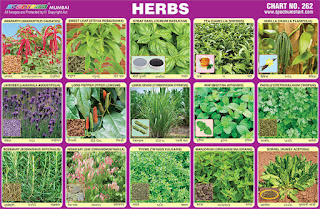 |
| Herbs Chart |
Spectrum Chart - 262 : Herbs
1. Amaranth (Amaranthus Caudatus) –
Amaranth is a cosmopolitan genus of herbs. Amaranth are cultivated as
leaf vegetables, pseudocereals and ornamental plants. Amaranth
species are cultivated and consumed as a leaf vegetable in many parts
of the world.
2. Sweet Leaf (Stevia Rebaudiana) -
Sweetleaf is a tender perennial native to parts of Brazil and
Paraguay. Sweet leaf is widely grown for its sweet leaves, which are
the source of sweetener products known generically as stevia and sold
under various trade names. The leaves can be eaten fresh or put in
teas and foods.
3. Great Basil (Ocimum Basilicum) - Basil
is herbaceous plant that belongs to mint family. It originates from
India, where people use it as spice and as medicine at least 5000
years. Basil has light green, silky leaves that are oval in shape.
Leaves are oppositely arranged on the stem. Basil can be used fresh
or in a dry form. Flower and leaves are edible, but leaves are more
often in use.
4. Tea (Camellia Sinensis) - Camellia
sinensis is a species of a small tree whose leaves and leaf buds are
used to produce tea. Camellia sinensis is native to East Asia, the
Indian Subcontinent and Southeast Asia, but it is today cultivated
across the world in tropical and subtropical regions. The leaves have
been used in traditional Chinese medicine and other medical systems
to treat asthma.
5. Vanilla (Vanilla Planifolia) –
Vanilla is a flavouring derived from orchids of the genus Vanilla.
Vanilla is the second-most expensive spice after saffron. Vanilla is
highly valued for its flavour. As a result, vanilla is widely used in
both commercial and domestic baking, perfume manufacture and
aromatherapy.
6. Lavender (Lavandula Angustifolia) -
Lavender is a type of flowering plant that belongs to the mint
family. Lavender grows in dry, sunny areas on well-drained soils.
Lavender develops simple, pinnate or multiple pinnate leaves
depending on the species. Leaves can be grey or green coloured. They
are often covered with fine hairs. Essential oils extracted from the
flowers of lavender are massively used in the industry of perfumes
and cosmetics. Lavender has antiseptic, antibacterial and
anti-depressant properties.
7. Long Pepper (Piper Longum) - Long
pepper is cultivated for its fruit, which is usually dried and used
as a spice and seasoning. Long pepper is a very rare ingredient in
European cuisines, but it can still be found in Indian and Nepalese
vegetable pickles.
8. Lemon Grass (Cymbopogon Citratus) -
Lemongrass, also known as citronella grass, originates from southern
parts of India and Sri Lanka. Lemongrass produces bluish green, thin,
blade-like leaves with drooping, pointed tips. Leaves change colour
from green to red during the autumn. Crushed leaves emit lemony
aroma. Lemongrass can be used fresh, dried or in the form of powder.
It represents an integral part of Asian cuisine. It can be also
consumed in the form of herbal teas, cocktails and other refreshing
beverages.
9. Mint (Mentha Arvesis) - Mint is
herbaceous plant that belongs to the family Lamiaceae. Mint grows in
temperate climate, usually on the moist soil in areas that provide
enough direct sunlight. Leaves of mint can be dark green,
greyish-green or purple in colour. They have lanceolate shape and
serrated edges. Leaves are grouped in pairs that are oppositely
arranged on the stem. Mint is rich source of vitamins A, C and B2.
Fresh or dry leaves of mint are used in the preparation of various
sweet or salty dishes.
10. Parsley (Petroselinum Crispum) -
Parsley is a type of herbaceous plant that belongs to the same family
as celery, carrot and cumin (Apiaceae). Parsley has bright green,
fern-like leaves that grow from centrally positioned green stem. Leaf
stems have stronger taste than leaves. It is used as an ingredient of
salads, soups, stews and dishes made of tomato, meat and fish.
Chewing of parsley can aid in elimination of bad breath.
11. Rosemary (Rosmarinus Officinalis) -
Rosemary is a plant that belongs to the Lamiaceae family. Rosemary
grows on dry and sandy soils, with enough sunlight during the day.
Rosemary has needle-like evergreen leaves. Rosemary is rich in
essential oil that has intense aroma. Because of that, rosemary is
often used in aromatherapy and in the preparation of various lotions
in cosmetic industry. Rosemary is often used in folk medicine to
enhance memory, to treat rheumatism, bruises, sores etc.
12. Indian Bay Leaf (Cinnamomum Tamala) -
Indian bay leaf is native to India, Bangladesh, Nepal, Bhutan and
China. It has aromatic leaves which are used for culinary and
medicinal purposes. It is thought to have been one of the major
sources of the medicinal plant leaves known in classic and medieval
times as malabathrum. The leaves, known as or tejpatta in Hindi are
used extensively in the cuisines of India, Nepal and Bhutan,
particularly in the Mughal cuisine of North India.
13. Thyme (Thymus Vulgaris) - Thyme is herb
that belongs to the family Lamiaceae. Thyme prefers sunny areas and
well-drained soil. It tolerates frost and drought. Thyme is evergreen
plant. It has small, aromatic leaves that are oval in shape.
Essential oils extracted from the leaves and flowers contain
substance called thymol. Thymol is active ingredient in the popular
mouthwashes.
14. Marjoram (Origanum Majorana) - Marjoram
is a somewhat cold-sensitive perennial herb with sweet pine and
citrus flavors. Marjoram is cultivated for its aromatic leaves,
either green or dry, for culinary purposes. Marjoram is used for
seasoning soups, stews, dressings and sauces.
15. Sorrel (Rumex Acetosa) - Sorrel is a
perennial herb in the family Polygonaceae. It is a common plant in
grassland habitats and is cultivated as a garden herb or leaf
vegetable. The leaves, when consumed raw, have a sour taste. Leaves
are used in soups and sauces or added to salads.

No comments:
Post a Comment